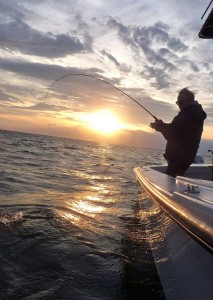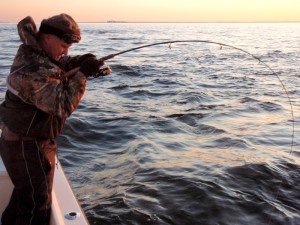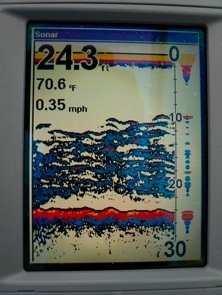water temperature
 Savvy Chesapeake anglers recognize an event that happens every fall that has significant impact on light tackle fishing. In summer months, the waters in most areas of the Chesapeake Bay stratify so that it is cooler, denser, and saltier down deep, but lighter and fresher near the surface. In the fall, as temperatures cool and strong cold fronts bring lots of wind, the water is stirred up so that the top layer eventually reaches the same density as it is down deep. When that happens the surface water sinks so that for a while, temperatures and salinity are about the same top to bottom. It doesn’t happen all over the Bay at the same time, but it’s easily recognizable to fishermen because we start noticing that fish are feeding at much deeper depths. In some parts of the Maryland portion of the Bay, we are currently experiencing the fall turnover. This can be both good and bad for fishing.
Savvy Chesapeake anglers recognize an event that happens every fall that has significant impact on light tackle fishing. In summer months, the waters in most areas of the Chesapeake Bay stratify so that it is cooler, denser, and saltier down deep, but lighter and fresher near the surface. In the fall, as temperatures cool and strong cold fronts bring lots of wind, the water is stirred up so that the top layer eventually reaches the same density as it is down deep. When that happens the surface water sinks so that for a while, temperatures and salinity are about the same top to bottom. It doesn’t happen all over the Bay at the same time, but it’s easily recognizable to fishermen because we start noticing that fish are feeding at much deeper depths. In some parts of the Maryland portion of the Bay, we are currently experiencing the fall turnover. This can be both good and bad for fishing.
 I’ve mentioned in previous reports that there are an extraordinary number of striped bass in the Bay this winter. It’s never been unusual to find a few big fish here and there during cold weather, but each year there seem to be more nice fish wintering over. I’ve managed a couple of trips this week with very good results as you can see in the photos below. Curious about why there are so many January rockfish, I put the question to Maryland Department of Natural Resources Senior Fisheries Biologist “Rockfish” Rudy Lukacovic when I ran into him at the Boatyard Bar & Grill in Annapolis one evening this week. Rudy thinks it’s all a part of changing migration patterns. He also noted that there have been fewer fish in the usual wintering grounds off the coast of the Carolinas in recent years. Read More!
I’ve mentioned in previous reports that there are an extraordinary number of striped bass in the Bay this winter. It’s never been unusual to find a few big fish here and there during cold weather, but each year there seem to be more nice fish wintering over. I’ve managed a couple of trips this week with very good results as you can see in the photos below. Curious about why there are so many January rockfish, I put the question to Maryland Department of Natural Resources Senior Fisheries Biologist “Rockfish” Rudy Lukacovic when I ran into him at the Boatyard Bar & Grill in Annapolis one evening this week. Rudy thinks it’s all a part of changing migration patterns. He also noted that there have been fewer fish in the usual wintering grounds off the coast of the Carolinas in recent years. Read More!
 It’s sometimes said that good fishermen think like a fish. While no one really knows what fish think, it’s usually possible to predict where they might be located based on climatic conditions and the time of year. Two very important factors to consider when looking for fish in the Chesapeake Bay are water temperature and salinity. Sometimes stripers congregate near underwater structure, at other times they travel in schools out in the open bay, but they always prefer specific depth zones which vary depending on the time of year. Fish are cold-blooded, so they’re more likely to be active in water that keeps them warmer in the winter and cooler in the summer. The “perfect” water temperature for stripers is around 68 degrees, but perfect conditions are rare. Since locating feeding fish is a fisherman’s primary challenge, it’s important to understand seasonally changing temperature zones in the Bay.
It’s sometimes said that good fishermen think like a fish. While no one really knows what fish think, it’s usually possible to predict where they might be located based on climatic conditions and the time of year. Two very important factors to consider when looking for fish in the Chesapeake Bay are water temperature and salinity. Sometimes stripers congregate near underwater structure, at other times they travel in schools out in the open bay, but they always prefer specific depth zones which vary depending on the time of year. Fish are cold-blooded, so they’re more likely to be active in water that keeps them warmer in the winter and cooler in the summer. The “perfect” water temperature for stripers is around 68 degrees, but perfect conditions are rare. Since locating feeding fish is a fisherman’s primary challenge, it’s important to understand seasonally changing temperature zones in the Bay.
Salinity and temperature are closely related in the Bay. Striped bass are classified as anadromous fish, meaning they live primarily in salt water but migrate to fresh water to spawn. While they can live and thrive in fresh water, they prefer water with some salinity. Scientific opinions are mixed as to the optimum salt content, but there’s no denying that salinity influences the behavior of rockfish in the Bay. This is especially true in the spring and fall when many fish are traveling to and from the ocean. Read More!


